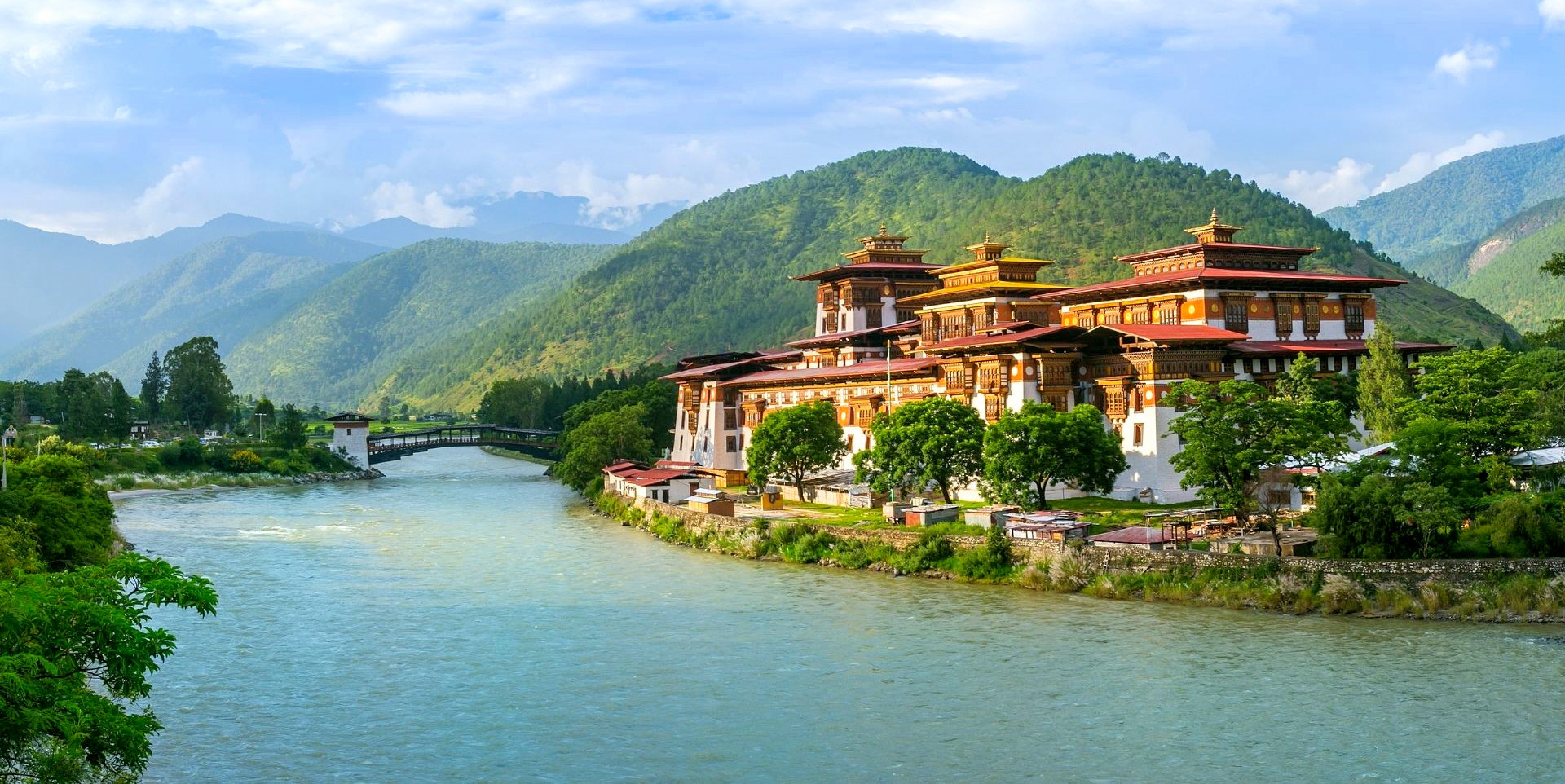Tashichho Dzong
Tashichho Dzong, also known as the "fortress of the glorious religion," is one of the most iconic and impressive structures in Thimphu, Bhutan. This historic dzong serves as both a religious and administrative center and is the seat of Bhutan's government. Here's a detailed look at this significant landmark:
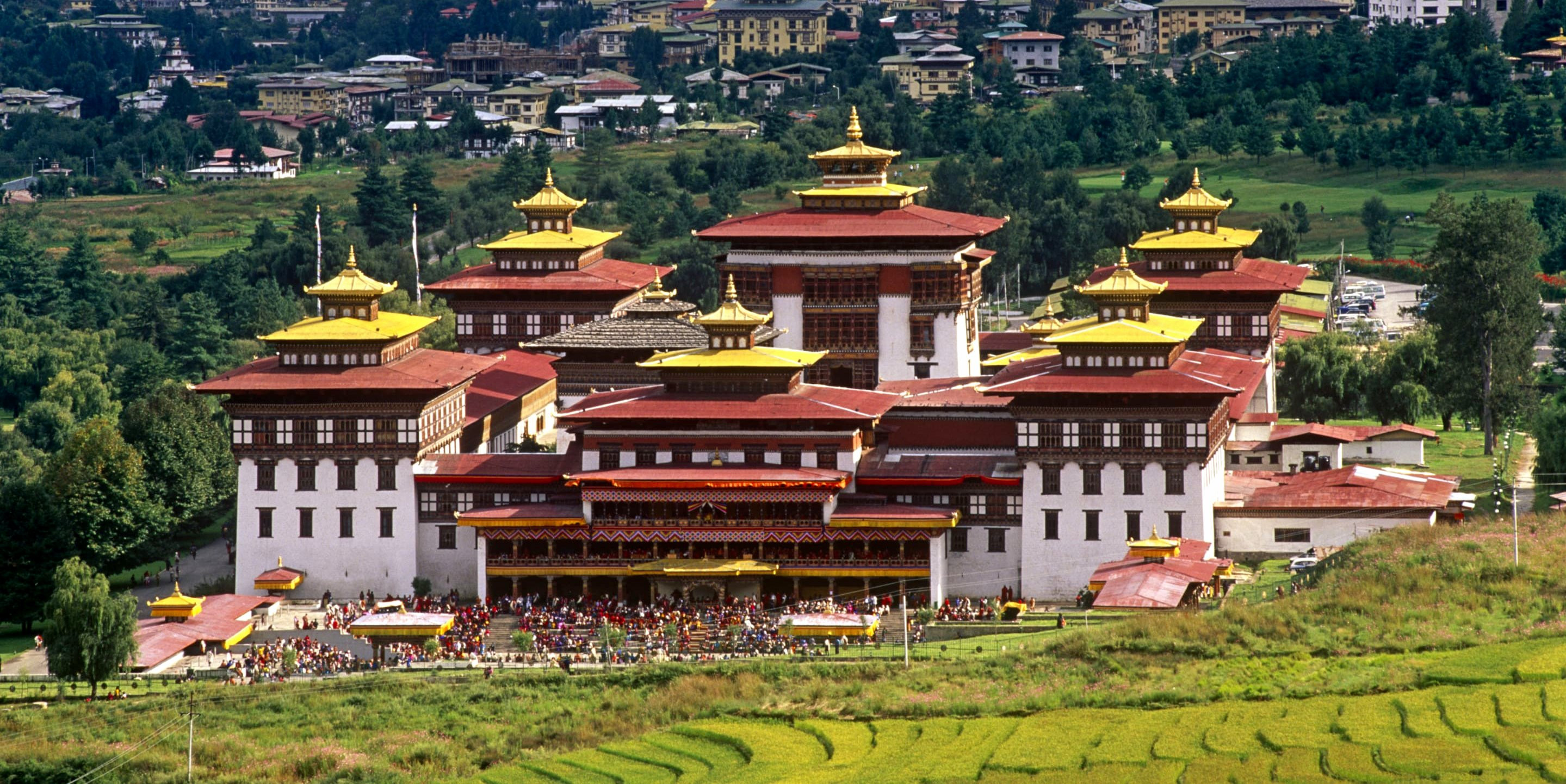
-
Historical Significance: Tashichho Dzong has been the traditional seat of the Druk Desi, the head of Bhutan's civil government, an office that has been combined with the kingship since the creation of the monarchy in 1907. The original dzong was constructed in 1641 by Zhabdrung Ngawang Namgyal and was later rebuilt in the 1960s by the third King of Bhutan, King Jigme Dorji Wangchuck, to replace the older structure that had been damaged by fire.
-
Architectural Features: The architecture of Tashichho Dzong is a splendid example of Bhutanese craftsmanship, featuring intricate woodwork and beautiful whitewashed walls that contrast with the richly carved, painted wood that adorns the windows and roofs. The dzong is a massive structure, covering an area of over 16,000 square meters. Its central tower, or utse, is an imposing sight and houses several temples and chambers used for official functions and ceremonies.
-
Cultural and Religious Importance: Tashichho Dzong is not only a political hub but also a religious one. It houses the offices of the King, the throne room, and various government ministries. It is also the summer residence of the Je Khenpo, the chief abbot of the Central Monastic Body of Bhutan. The dzong hosts several important cultural and religious festivals, including the Thimphu Tshechu, one of Bhutan's grandest religious festivals. During this festival, the dzong comes alive with vibrant mask dances, music, and religious allegorical plays that draw spectators from across the globe.
-
Accessibility and Tourism: Tashichho Dzong is open to tourists during the Thimphu Tshechu and when the Je Khenpo is residing elsewhere. Visitors are allowed in the courtyards and some parts of the dzong but need to respect the sanctity of the site, dressing modestly and following local customs. The evenings are particularly beautiful when the fortress is lit up, highlighting its architectural details against the night sky.
Tashichho Dzong remains a profound symbol of the harmonious blend of governance and religion in Bhutan, reflecting the deeply spiritual and traditional nature of the Bhutanese state. It's a must-visit for anyone interested in the rich history and cultural heritage of Bhutan.
Buddha Dordenma Statue
The Buddha Dordenma Statue is a monumental figure located in Thimphu, the capital of Bhutan. This majestic statue not only serves as a significant cultural and religious symbol but also offers an impressive sightseeing opportunity for visitors.
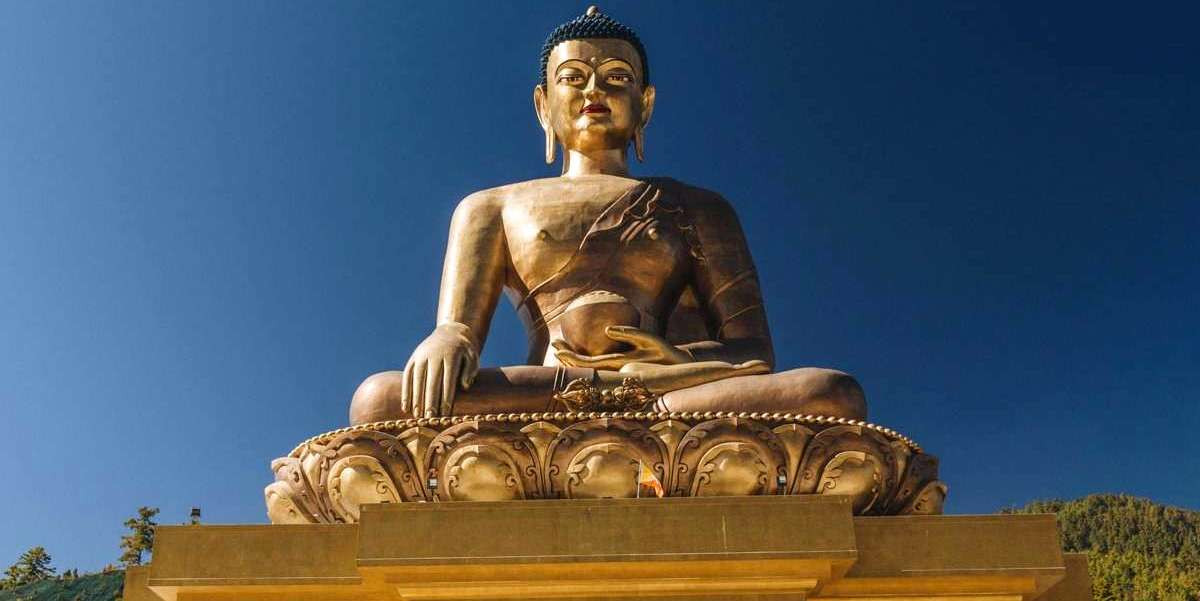
-
Overview: Standing at a height of 51 meters (167 feet), the Buddha Dordenma is one of the largest Buddha statues in the world. It is situated atop a hill in Kuenselphodrang Nature Park, overlooking the southern entrance to Thimphu Valley. The statue is made of bronze and is gilded in gold, adding to its grandeur and visibility from various points around the city.
-
Historical and Cultural Significance: The statue commemorates the 60th anniversary of the fourth king Jigme Singye Wangchuck's birth. It symbolizes the presence of Buddhism in Bhutan and serves as a beacon of peace and prosperity for the entire kingdom. Inside the statue, there are 125,000 smaller Buddha statues, each of which, like the main statue, is also made of bronze and gilded in gold.
-
Spiritual Importance: The Buddha Dordenma is considered an emanation of Buddha Shakyamuni and is believed to emanate an aura of peace and happiness to the entire world. The site is not only a place of worship but also a space for reflection and meditation. It attracts thousands of pilgrims and tourists who come to offer prayers, meditate, or simply soak in the panoramic views of the valley below.
-
Architectural Features: The statue is housed in a meditation hall, which is situated beneath it. This hall is adorned with beautiful murals and paintings that depict various aspects of Buddhist lore. The construction is an architectural feat, considering the size and the detail involved in crafting and assembling the statue.
-
Visiting the Site: The Buddha Dordenma is accessible by road and is a short drive from central Thimphu. Visitors can explore the meditation hall and the surrounding area, which includes beautifully landscaped gardens and a serene environment for walking and reflection. The site offers spectacular views of Thimphu, especially at sunrise or sunset, making it a perfect location for photography enthusiasts.
The Buddha Dordenma Statue is not just a testament to the skilled craftsmanship and religious fervor of Bhutan but also a must-visit destination for anyone traveling to Thimphu, providing a profound insight into the spiritual and cultural ethos of this Himalayan kingdom.
Memorial Chorten
The Memorial Chorten in Thimphu is one of the most iconic religious structures in Bhutan, serving as a focal point of devotion for the local population and a must-visit site for tourists exploring the spiritual aspects of Bhutanese culture.
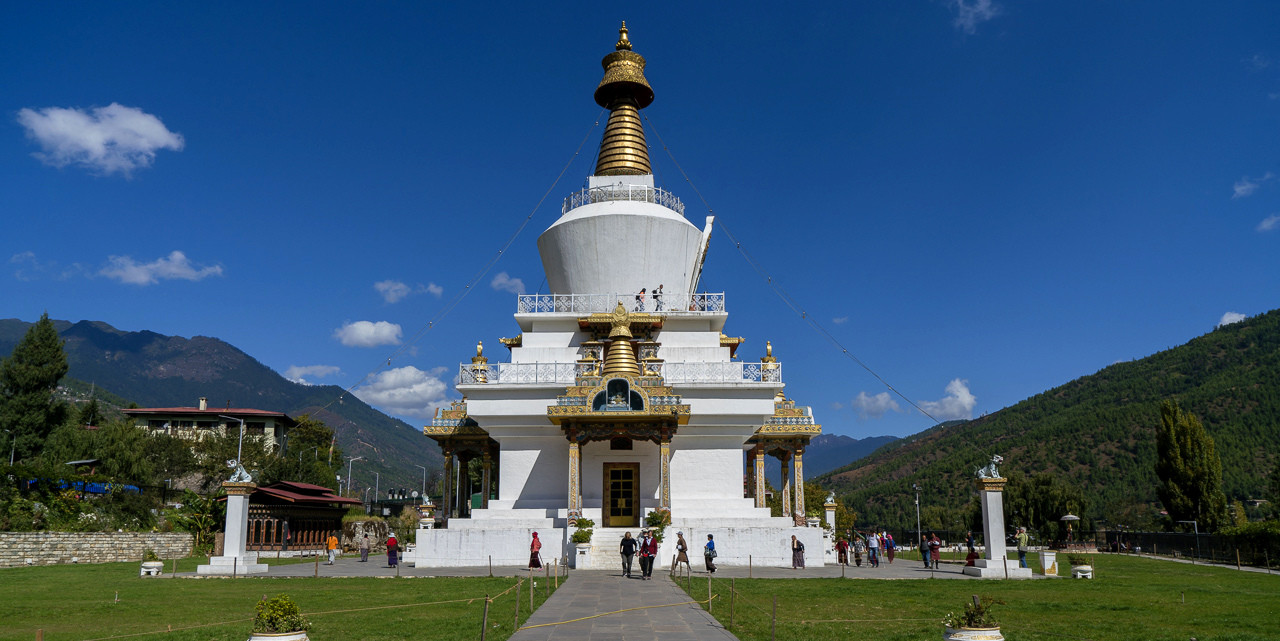
-
Overview: The Memorial Chorten, also known as the Thimphu Chorten, was constructed in 1974 in memory of the third King of Bhutan, King Jigme Dorji Wangchuck, who is often regarded as the father of modern Bhutan. This stupa is one of the most visible religious structures in Thimphu and stands as a symbol of peace and prosperity.
-
Architectural Features: Unlike many traditional Bhutanese chortens, the Memorial Chorten is not designed as a repository for relics but as a monument to world peace and prosperity. The architecture features a classical Bhutanese stupa design, with richly carved annexes facing the four directions, and intricate mandalas, statues, and a shrine dedicated to the late King. The exterior is highly decorative and prominently features golden spires and bells.
-
Cultural and Religious Significance: The Memorial Chorten holds great religious significance for the people of Bhutan. It is seen as a living representation of the late King, who wished to establish a monument to world peace and prosperity. The chorten continuously attracts people of all ages, who come to circumambulate the structure while reciting prayers and spinning the large prayer wheels.
-
Daily Activities: Every day, the Memorial Chorten becomes a gathering place for the elderly, pilgrims, and monks who come to pray and meditate. It is particularly busy during early mornings and evenings when locals visit to pay their respects and perform religious rituals. The chorten also hosts important religious gatherings and ceremonies, particularly on special Buddhist dates when the site is filled with vibrant festivities and rituals.
-
Visiting the Site: Visitors to the Memorial Chorten can observe and participate in these daily rituals, offering a unique glimpse into the spiritual practices of Bhutanese Buddhism. The site is open to the public, and there is no entry fee, although respectful behavior and modest dress are expected from all visitors.
The Memorial Chorten not only commemorates Bhutan's revered king but also serves as a center of daily worship and a beacon of peace. It's a poignant place that embodies the spirit and religious fervor of the Bhutanese people, making it an essential stop for anyone wanting to understand more about Bhutan's culture and religious practices.
Motithang Takin Preserve
The Motithang Takin Preserve in Thimphu is a unique wildlife reserve dedicated to protecting the Takin, Bhutan’s national animal. This preserve is an essential visit for wildlife enthusiasts and those interested in Bhutanese fauna.
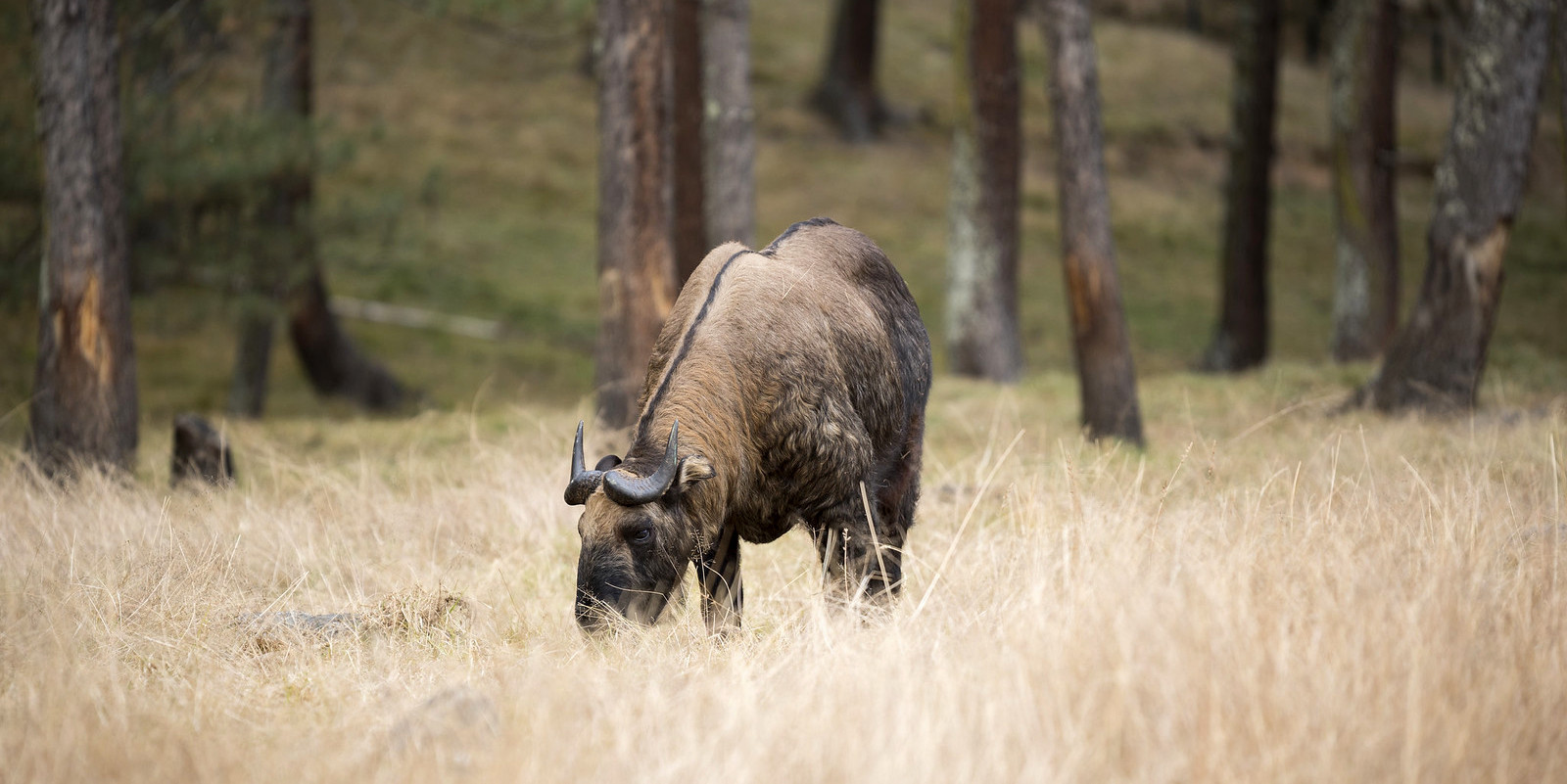
-
Overview: Originally established as a zoo, the Motithang Takin Preserve was converted into a preserve when the King of Bhutan decreed that it was improper for a Buddhist country to confine animals for display. Instead, the area was turned into a conservation area where Takins could roam freely and be observed in a more natural setting.
-
The Takin: The Takin (Budorcas taxicolor) is a peculiar-looking animal, often described as having the body of a cow and the head of a goat. Its unique appearance has given rise to various local myths and legends, notably one involving the divine madman, Lama Drukpa Kunley. According to legend, the Lama created the Takin by assembling the bones of a cow and a goat and bringing it to life, hence its unusual features.
-
Conservation and Natural Habitat: The Motithang Takin Preserve covers an area that allows visitors to observe these animals in a setting that closely mimics their natural habitat. The preserve not only protects the Takin but also educates the public about the importance of wildlife conservation in Bhutan. Efforts to maintain and protect this species are vital, given its status as a vulnerable species.
-
Visiting the Preserve: The preserve is located just a short drive from the center of Thimphu, making it an accessible spot for a morning or afternoon visit. Trails in the preserve offer the chance to not only see Takins but also to spot other local wildlife and enjoy the lush, forested landscape of the area. Informational signs around the preserve provide interesting facts about the Takin and the local ecology.
-
Experience for Visitors: Visiting the Motithang Takin Preserve provides a rare opportunity to see one of the most unusual and lesser-known animals in the world in its natural environment. It’s a perfect addition to any itinerary for those looking to combine cultural and natural exploration in Bhutan.
The preserve is an excellent example of Bhutan's commitment to conservation and offers a unique insight into the kingdom's flora and fauna. Whether you’re a nature lover, a wildlife photographer, or just curious about Bhutan’s national animal, the Motithang Takin Preserve is a rewarding and educational experience.
National Folk Heritage Museum
The National Folk Heritage Museum in Thimphu offers visitors a deep dive into the traditional Bhutanese lifestyle, showcasing the rich cultural heritage of this Himalayan kingdom. This museum plays a crucial role in preserving and exhibiting the daily lives, customs, and traditions of Bhutanese people across the ages.
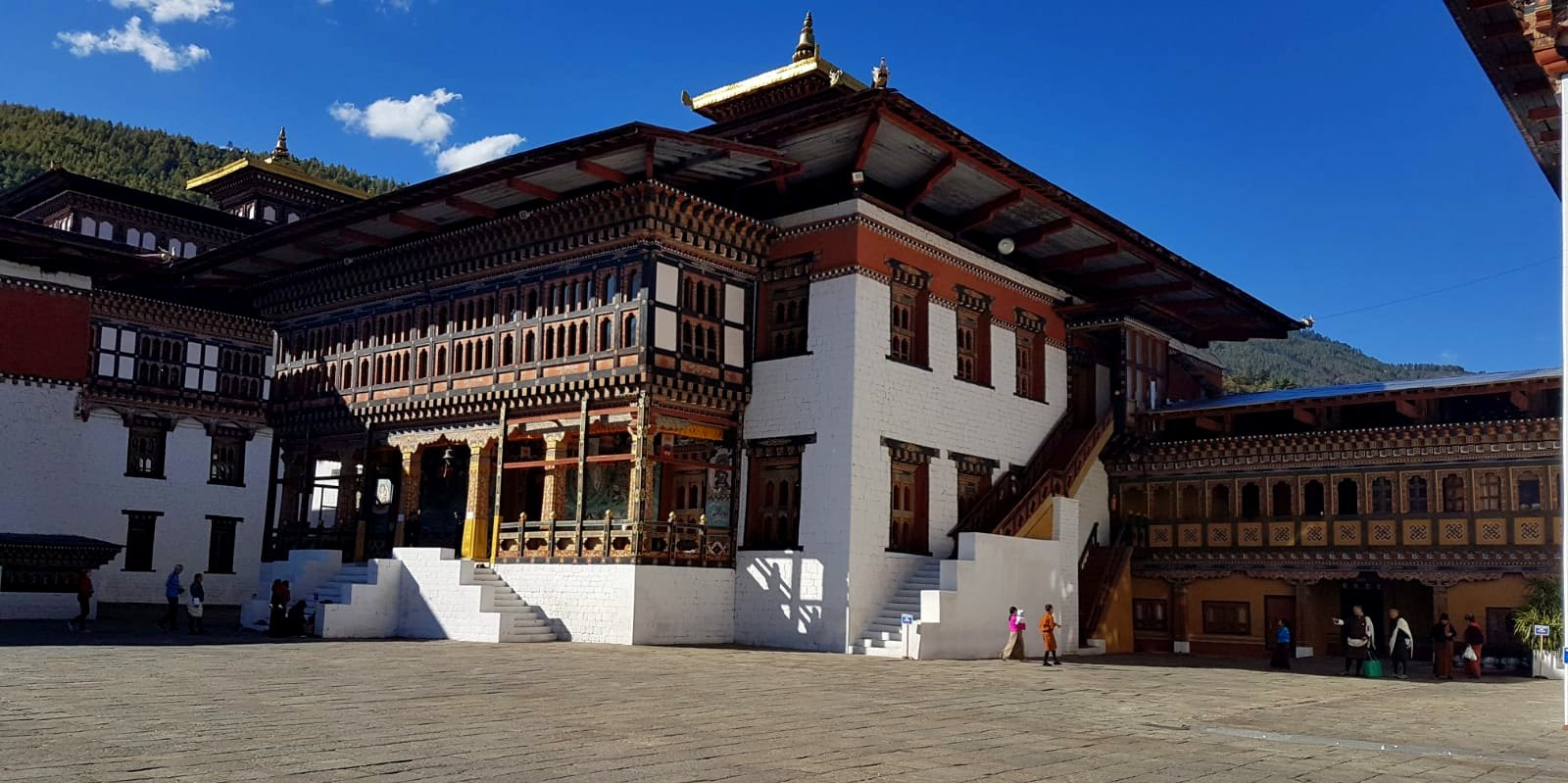
-
Overview: Established to connect present and future generations with Bhutan's rural past, the National Folk Heritage Museum is housed in a traditional three-story timber and rammed earth building, which is over 150 years old. This building itself is an excellent example of traditional Bhutanese architecture, providing an authentic backdrop for the artifacts and exhibits displayed within.
-
Exhibits and Collections: The museum’s collection includes a variety of household objects, tools, and equipment used in rural Bhutanese households, many of which are still used to this day, demonstrating the continuity of Bhutanese culture. The exhibits are arranged to mimic a typical Bhutanese family home, complete with a traditional kitchen, barn, and living quarters. This setup gives visitors a realistic impression of everyday life in a traditional Bhutanese home.
-
Cultural Demonstrations: One of the highlights of visiting the National Folk Heritage Museum is the live demonstrations of rural traditions. Depending on the season, visitors might witness the preparation of local foods, traditional brewing of Ara (a local alcoholic beverage), or cultural performances. These demonstrations provide a hands-on learning experience about Bhutanese culture and traditions.
-
Educational Programs: The museum is not just a tourist attraction but also serves as an educational center. It offers programs for students and researchers interested in learning about Bhutan's cultural heritage, agricultural practices, and rural life. Workshops and seminars are frequently held to discuss and disseminate knowledge on preserving Bhutanese culture.
-
Visiting the Museum: The National Folk Heritage Museum is conveniently located in Thimphu, making it easily accessible for visitors. It's open throughout the week, except for government holidays, and there is a small entry fee. The museum also features a small garden where traditional plants and herbs are grown, adding an extra layer of authenticity to the visitor experience.
For anyone interested in understanding the real Bhutan beyond its monasteries and dzongs, a visit to the National Folk Heritage Museum is essential. It offers a vivid snapshot of Bhutanese rural life and traditions, making it a key educational and cultural resource in Thimphu. Whether you're a history buff, a cultural enthusiast, or simply curious about traditional Bhutanese ways of life, this museum provides a comprehensive and engaging look at the heritage of this fascinating country.
Thimphu Weekend Market
The Thimphu Weekend Market is a vibrant and bustling hub of activity that forms an integral part of life in Bhutan's capital city. Situated along the banks of the Wang Chhu river, it is a place where tradition meets the everyday needs of the Thimphu residents, and it offers a fascinating insight into the local culture for visitors.
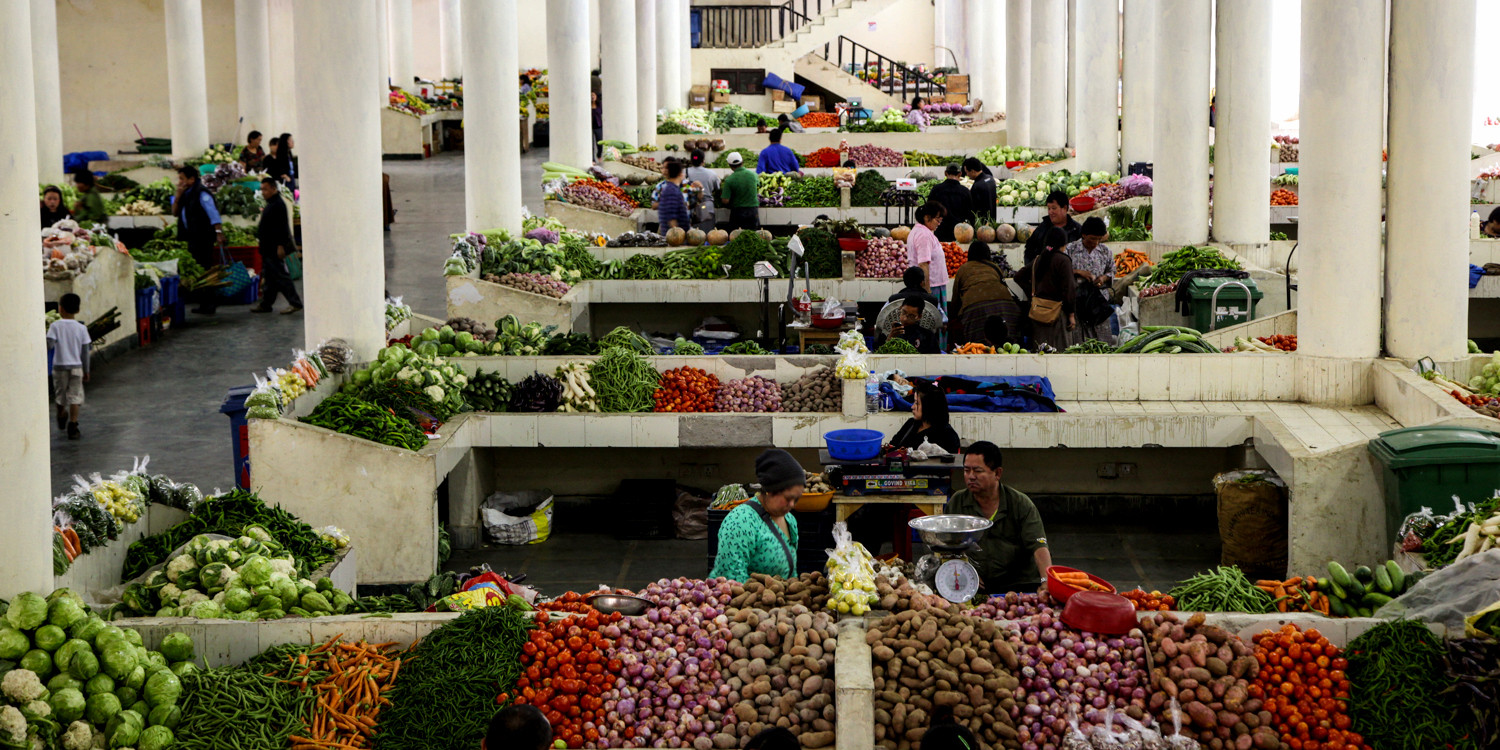
-
Overview: The market operates primarily on the weekends, from Friday to Sunday, and is one of the largest domestic markets for the farmers of Bhutan. Local vendors from throughout the region come here to sell their produce, ranging from fresh fruits and vegetables to handmade crafts and textiles. The market is a place for buying and selling goods and a social venue where people from different parts of the country mingle and catch up.
-
What to Expect: Visitors to the Thimphu Weekend Market can explore numerous stalls spread across several sections. One area is dedicated to fresh, organic produce including seasonal fruits, vegetables, and herbs. Another section offers a wide array of Bhutanese spices and condiments, essential for creating the distinctive flavors of Bhutanese cuisine.
-
Local Crafts and Textiles: Apart from food items, the market is a treasure trove of traditional Bhutanese handicrafts and textiles. Shoppers can find hand-woven textiles, intricate thangkas (Buddhist religious paintings), wooden bowls, bamboo items, and handmade paper products. These crafts reflect the skill and artistry of Bhutanese artisans and are ideal for souvenirs or gifts.
-
Cultural Experience: For those looking to immerse themselves in Bhutanese culture, the Thimphu Weekend Market is a must-visit. The market provides a lively and colorful tableau of Bhutanese life, offering insights into the dietary habits and artisanal skills of the locals. It's also an excellent place to try local snacks and street food, including momos (dumplings), ema datshi (chili cheese), and suja (butter tea).
Tips for Visitors
-
Timing: Early mornings are the best time to visit the market to avoid the crowds and experience the hustle and bustle of vendors setting up their stalls.
-
Bargaining: While prices are generally reasonable, some bargaining is acceptable, especially if buying in larger quantities or purchasing high-value items like textiles.
-
Cash: Ensure to carry cash, as most vendors do not accept credit cards.
The Thimphu Weekend Market offers a slice of Bhutanese life and is a colorful, sensory experience that is as much about observing local life as it is about shopping. Whether you are a culinary enthusiast, a lover of crafts, or simply someone curious about Bhutanese culture, the market provides a window into the daily lives and traditions of the people of Thimphu.
Tips for Top Places to Visit in Thimphu
Visiting Thimphu, Bhutan’s capital city, offers a rich blend of cultural and natural attractions. To make the most of your trip, here are some essential tips for exploring the top places in Thimphu:
-
Plan Your Visit Around Festivals: Thimphu is famous for its colorful festivals, particularly the Thimphu Tshechu. Planning your trip to coincide with these festivals can provide a deeper insight into the culture and traditions of Bhutan.
-
Dress Appropriately: When visiting religious sites like Tashichho Dzong and Memorial Chorten, dress modestly. Shoulders and knees should be covered, and hats should be removed as a sign of respect.
-
Carry Cash: While some places may accept credit cards, many smaller shops, markets (like the Thimphu Weekend Market), and entry fees at certain sites require cash. Having local currency on hand is essential.
-
Respect Local Customs: Bhutanese culture is deeply rooted in Buddhism and local traditions. Show respect by being mindful of local customs, such as not pointing your feet at people or religious artifacts, and always asking permission before taking photographs, especially of people.
-
Hire a Local Guide: For a more enriching experience, consider hiring a local guide. Not only can they provide historical context and deeper insights into the sites you visit, but they can also help with language barriers and recommend less-known spots.
-
Explore Nature: Don’t miss out on the natural beauty surrounding Thimphu. Visiting the Buddha Dordenma Statue offers not only a spiritual experience but also panoramic views of the valley. The Motithang Takin Preserve is another must-see for wildlife enthusiasts.
-
Stay Hydrated and Acclimatized: Thimphu is at a high altitude, so it’s essential to stay hydrated and give yourself time to acclimatize to avoid altitude sickness. Take it easy the first few days if you're not used to high elevations.
-
Check for Entry Requirements: Bhutan has strict entry requirements, including mandatory minimum daily spending and the need for all tourists (except Indian, Bangladeshi, and Maldivian passport holders) to have a visa. Ensure you meet all entry requirements before planning your journey.
-
Sample Local Cuisine: Bhutanese cuisine is unique, and Thimphu offers a range of dining options that allow you to try local dishes like Ema Datshi (chili and cheese) and Ara (a traditional alcoholic beverage).
-
Stay Connected: While Thimphu is modernizing, Wi-Fi can still be spotty in places. Purchase a local SIM card if you need consistent internet access.
These tips will help ensure that your visit to Thimphu is enjoyable, culturally enriching, and as hassle-free as possible, allowing you to fully immerse yourself in the beauty and tranquility of Bhutan.
Rules and Rules and Regulations
When traveling to a new destination, especially one with a distinct cultural and legal landscape like Thimphu, Bhutan, it's crucial to be aware of the rules and regulations to ensure a respectful and trouble-free experience. Here are some important rules and regulations to consider:
Visa and Entry Requirements
-
All international tourists (except citizens of India, Bangladesh, and the Maldives) must obtain a visa before arriving in Bhutan.
-
You must book your trip through a Bhutanese tour operator or one of their international partners.
-
The government imposes a daily minimum spending requirement, which covers accommodation, food, transport, and an official guide.
Dress Code
-
When visiting religious sites, you should wear modest clothing that covers your shoulders and knees. Hats should be removed inside religious buildings.
-
It is respectful to wear semi-formal attire when visiting any government-owned sites and offices.
Photography
-
Always ask for permission before taking photos of people, especially monks.
-
Photography inside the main temples or dzongs may be restricted or prohibited. Look for signs or ask your guide about the specific rules at each site.
Environmental Care
-
Bhutan is known for its environmental consciousness. Littering is frowned upon, and in many cases, there are strict penalties.
-
Always dispose of your trash properly and consider using biodegradable or reusable materials.
Cultural Sensitivity
-
Show respect during your interactions with locals and observe local customs. For example, it's customary to bow your head slightly as a greeting.
-
Public displays of affection are not common in Bhutan and should be avoided.
Religious Respect
-
Bhutan is a deeply Buddhist country. Respect religious sentiments by not touching religious artifacts or entering prayer areas without permission.
-
Turning prayer wheels in the clockwise direction and circumambulating shrines or chortens in a clockwise direction is expected.
Alcohol and Smoking
-
The sale of tobacco is banned in Bhutan, and smoking in public areas is illegal. However, tourists can bring a small quantity of tobacco products for personal use, subject to heavy duties.
-
Alcohol is available and can be consumed, but public intoxication is looked down upon.
Wildlife and Natural Resources
-
Do not disturb wildlife or take any natural souvenirs such as plants or rocks from natural sites.
-
Fishing and hunting are generally prohibited, given the country's strong environmental conservation laws.
Currency Regulations
- The Bhutanese currency is the Ngultrum (BTN), which is pegged to the Indian Rupee (also an accepted currency in Bhutan). Be aware that credit card acceptance is limited outside major hotels and tourist shops.
Legal Compliance
- Always adhere to local laws and regulations. Drug offenses, for example, carry severe penalties.
Understanding and adhering to these rules and regulations will not only make your visit to Thimphu more enjoyable but also help maintain the respect and integrity that Bhutan cherishes.
Best Time for Top Places to Visit in Thimphu
Visiting Thimphu, Bhutan, offers a unique experience at any time of the year, but choosing the best time depends on what you're looking to get out of your trip. Here's a seasonal guide to help you plan the optimal time for exploring the top places in Thimphu:
-
Spring (March to May): Spring is one of the best times to visit Thimphu. The weather is pleasantly mild, and the valleys are vibrant with blooming flowers, including the famous rhododendrons. This season is ideal for trekking and exploring outdoor attractions like the Buddha Dordenma Statue and Motithang Takin Preserve. Visibility is excellent, making it a great time for photography enthusiasts.
-
Summer (June to August): Summer in Thimphu is marked by the monsoon, which can bring heavy rains, especially in July and August. While the rain might restrict some outdoor activities, the landscape becomes lush and green, offering stunning views. If you don't mind the occasional shower, this season also features fewer tourists, providing a more solitary experience at popular sites. Additionally, the Thimphu Summer Festival, showcasing the rich culture of the nomadic herders, occurs during this period.
-
Autumn (September to November): Autumn is arguably the most popular time to visit Thimphu due to the clear skies and mild weather. This season also coincides with the spectacular Thimphu Tshechu, one of Bhutan’s grandest festivals, held at the Tashichho Dzong. It's a perfect time for cultural immersion and for enjoying the grandeur of the Himalayas in their full glory. Sightseeing and outdoor activities are highly enjoyable during these months.
-
Winter (December to February): Winter in Thimphu can be cold, but it offers its own charm. The skies are usually clear, providing beautiful views of the snow-capped mountains surrounding the valley. This season is quieter in terms of tourism, which means you can explore the city’s attractions, such as the National Folk Heritage Museum and Memorial Chorten, without the crowds. It’s also a great time for bird watching and enjoying the serene winter landscape.
Tips for Visiting
-
Always check the festival dates each year as they follow the lunar calendar and can shift annually.
-
Regardless of the season, it’s wise to pack layers due to the variability in temperature throughout the day, especially if you are planning to trek or explore higher altitudes.
-
Book accommodations and travel arrangements well in advance if you plan to visit during peak seasons (spring and autumn) or during major festivals.
Choosing the right time to visit Thimphu can enhance your experience, whether you're looking for cultural festivities, natural beauty, or pleasant weather for outdoor activities. Each season in Thimphu has its unique attractions, making it a year-round destination.
Thimphu stands as a captivating blend of culture, history, and natural beauty, offering a diverse array of attractions that cater to every type of traveler. From the majestic Buddha Dordenma Statue to the historic Tashichho Dzong and the lively Thimphu Weekend Market, there's much to explore in Bhutan’s capital. Whether you're drawn by the call of nature, the allure of history, or spiritual pursuits, Thimphu promises a memorable and enriching experience. Align your visit with local festivals to fully embrace the vibrant culture of this unique Himalayan city.
FAQs for Top Places to Visit in Thimphu
Q: What is the best time to visit Thimphu?
A: The optimal times to visit Thimphu are during the spring (March to May) and autumn (September to November) when the weather is pleasant and the city hosts vibrant festivals like the Thimphu Tshechu.
Q: Do I need a visa to visit Thimphu?
A: Yes, except for citizens of India, Bangladesh, and the Maldives, all visitors to Bhutan require a visa. You must arrange your visa through a registered tour operator prior to your arrival.
Q: What are the must-see attractions in Thimphu?
A: Key attractions in Thimphu include Tashichho Dzong, Buddha Dordenma Statue, Memorial Chorten, Motithang Takin Preserve, and the National Folk Heritage Museum.
Q: Is it easy to find accommodation in Thimphu?
A: Thimphu offers various accommodations, from luxury hotels to modest guesthouses. Booking in advance is recommended, especially during peak seasons and festival periods.
Q: What type of clothing should I pack for a trip to Thimphu?
A: Dress modestly and prepare for varying temperatures. Layered clothing is advised, along with warm garments for cooler evenings, particularly in winter. Ensure shoulders and knees are covered when visiting religious sites.
Q: Can I use credit cards in Thimphu?
A: Major hotels, restaurants, and tourist shops usually accept credit cards, but smaller vendors and markets generally do not. Carrying some cash in the local currency, the Bhutanese Ngultrum, is wise.
Q: What local cuisine should I try in Thimphu?
A: Definitely try Ema Datshi (chili and cheese), Momos (dumplings), and Red Rice. Also, sample Suja (butter tea), a traditional Bhutanese drink.
Q: Are there any cultural norms I should be aware of?
A: Bhutanese culture values respect and etiquette highly. Always ask for permission before taking photographs, particularly of people and religious sites. Avoid public displays of affection as they are uncommon.
Q: How can I get around Thimphu?
A: Thimphu can be explored on foot for most locations, but taxis are available for longer distances. For convenience, especially for visiting sites outside the city, consider hiring a car with a driver through your tour operator.
Q: What are some tips for visiting religious sites in Thimphu?
A: Show respect by removing your shoes before entering temple areas, wearing appropriate clothing, walking clockwise around religious monuments, and spinning prayer wheels in the same direction.
For the Nepal tour, please click here.
If you are looking for different kinds of Nepal Tours or Trekking Packages, feel free to contact us.
